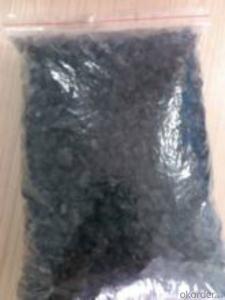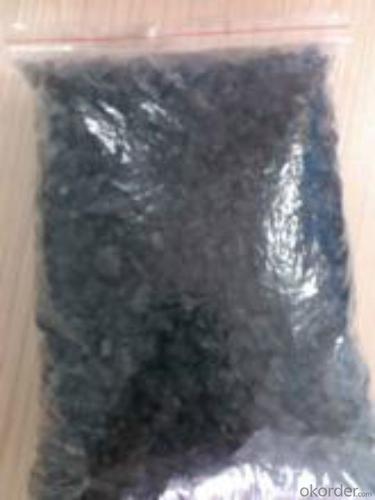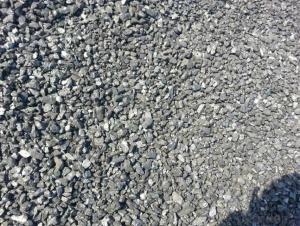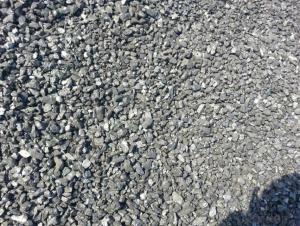S0.5% Recarburizer GCA for mills manufactured in China
- Loading Port:
- Tianjin
- Payment Terms:
- TT OR LC
- Min Order Qty:
- 21.4
- Supply Capability:
- 1014 m.t./month
OKorder Service Pledge
OKorder Financial Service
You Might Also Like
Specification
Introduction:
Calcined anthracite can be called carbon additive, carbon raiser, recarburizer, injection coke, charging coke, gas calcined anthracite.It is playing more and more important role in the industry
Best quality Anthracite as raw materials through high temperature calcined at over 2000℃ by the DC electric calciner with results in eliminating the moisture and volatile matter from Anthracite efficiently, improving the density and the electric conductivity and strengthening the mechanical strength and anti-oxidation. It has good characteristics with low ash, low resistivity, low sulphur, high carbon and high density. We are one of biggest suppliers for meatlluegical raw materials It is the best material for high quality carbon products. It is used as carbon additive in steel industry or fuel.
Features:
G-High Calcined Anthracite is produced when Anthracite is calcined under the temperature of 1240°C in vertical shaft furnaces. G-High Calcined Anthracite is mainly used in electric steel ovens, water filtering, rust removal in shipbuilding and production of carbon material.
Specifications:
F.C.% | 95MIN | 94MIN | 93MIN | 92MIN | 90MIN | 85MIN | 84MIN |
ASH % | 4MAX | 5MAX | 6 MAX | 6.5MAX | 8.5MAX | 12MAX | 13MAX |
V.M.% | 1 MAX | 1MAX | 1.0MAX | 1.5MAX | 1.5MAX | 3 MAX | 3 MAX |
SULFUR % | 0.3MAX | 0.3MAX | 0.3MAX | 0.35MAX | 0.35MAX | 0.5MAX | 0.5MAX |
MOISTURE % | 0.5MAX | 0.5MAX | 0.5MAX | 0.5MAX | 0.5MAX | 1MAX | 1MAX |
Pictures
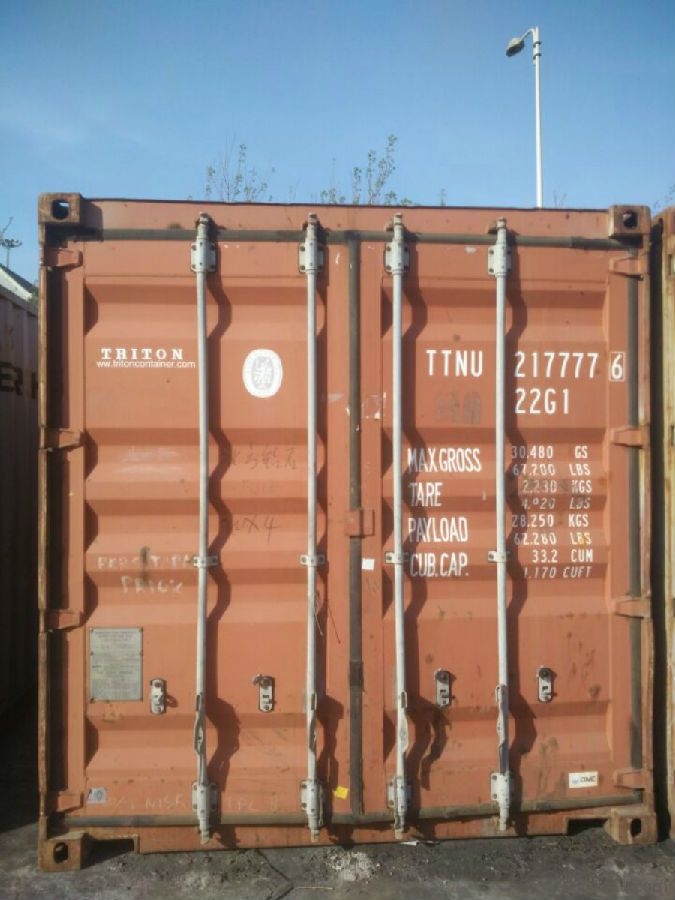
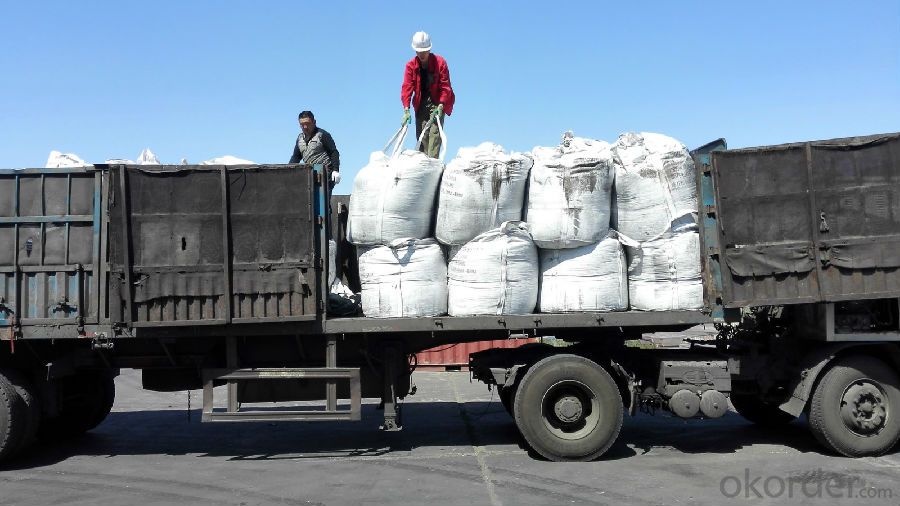
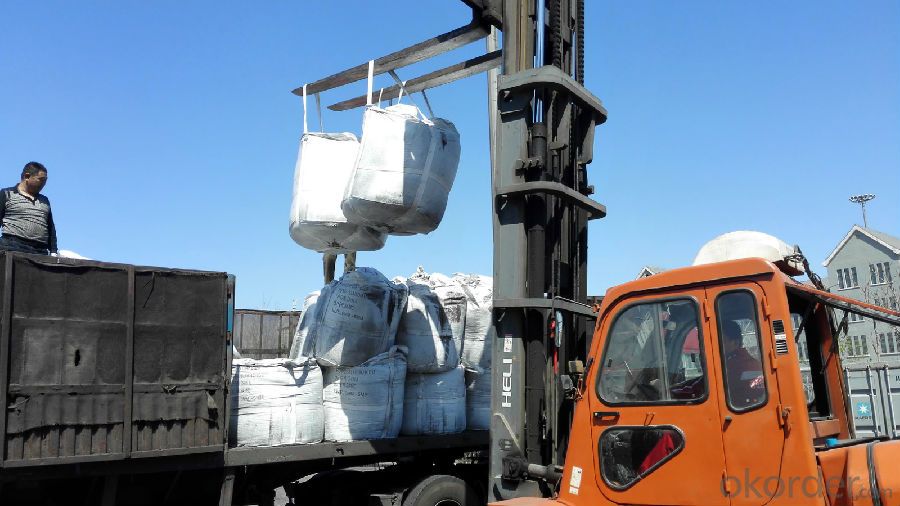
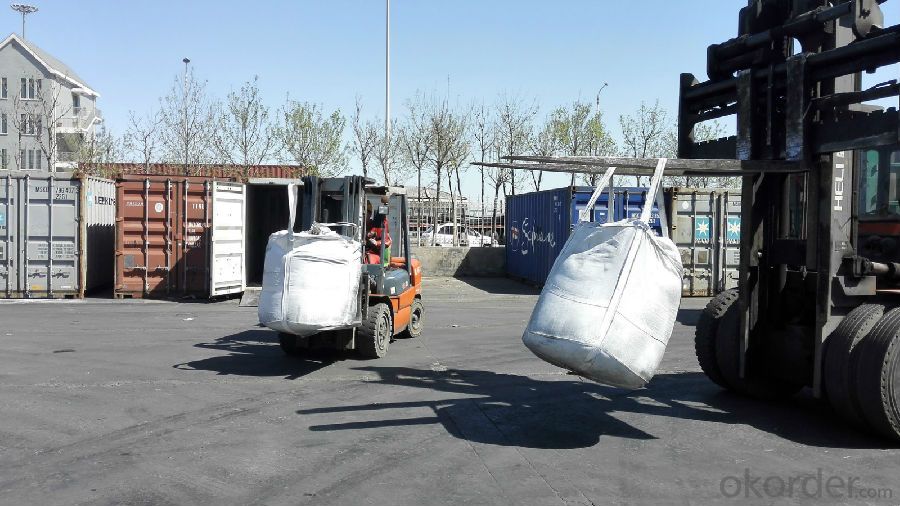
FAQ:
Packing:
(1). Waterproof jumbo bags: 800kgs~1100kgs/ bag according to different grain sizes;
(2). Waterproof PP woven bags / Paper bags: 5kg / 7.5kg / 12.5kg / 20kg / 25kg / 30kg / 50kg small bags;
(3). Small bags into jumbo bags: waterproof PP woven bags / paper bags in 800kg ~1100kg jumbo bags.
Payment terms
20% down payment and 80% against copy of B/L.
Workable LC at sight,
- Q: How does carbon affect the migration patterns of animals?
- The migration patterns of animals are significantly influenced by carbon emissions and the subsequent increase in greenhouse gases. One of the main ways in which carbon affects migration is through climate change. As levels of carbon dioxide rise, the Earth's temperature also increases, leading to changes in weather patterns and the timing of seasons. These alterations can disrupt the natural cues and signals that animals depend on to initiate migration. For certain species, migration is triggered by changes in temperature, daylight hours, or the availability of food sources. However, with climate change, these cues may become inconsistent or modified, resulting in confusion and disruption in migration patterns. Migratory birds, for instance, rely on the presence of insects and other food sources during their journey. Nevertheless, fluctuations in temperatures and shifts in the life cycles of plants and insects can impact the timing and availability of these resources, potentially leading to food shortages and hindering their ability to successfully complete migrations. Furthermore, carbon emissions have caused changes in habitat and ecosystems that further influence migration patterns. Increasing temperatures and alterations in precipitation patterns can change the distribution and abundance of plant species. Consequently, this can affect the availability of food and shelter for migratory animals. Some species may find that their traditional breeding or feeding grounds are no longer suitable due to these changes, compelling them to modify their migration routes or patterns. In addition, carbon emissions also contribute to the melting of polar ice caps and the subsequent rise in sea levels. This directly affects marine species that rely on specific breeding grounds or feeding areas. As their habitats shrink or disappear, these animals may be compelled to migrate to new areas or face extinction. Overall, the rise in carbon emissions and resulting climate change have profound effects on the migration patterns of animals. Disruptions in weather patterns, modified cues for migration, changes in habitat, and shifts in food availability all contribute to the challenges faced by migratory species. Understanding and mitigating the impact of carbon on migration is essential to ensure the survival and well-being of these animals in a rapidly changing world.
- Q: How does carbon affect the formation of acid rain?
- Carbon does not directly affect the formation of acid rain. Acid rain is primarily caused by the emissions of sulfur dioxide (SO2) and nitrogen oxides (NOx) from the burning of fossil fuels, such as coal and oil. However, carbon dioxide (CO2) emissions, which are also released from burning fossil fuels, contribute to climate change and indirectly affect the formation of acid rain. The increased levels of carbon dioxide in the atmosphere trap heat, leading to global warming. This, in turn, alters weather patterns and increases the frequency and intensity of extreme weather events. These changes can enhance the formation of acid rain by altering the dispersion patterns of sulfur dioxide and nitrogen oxides. Additionally, the combustion of fossil fuels that release carbon dioxide also releases sulfur dioxide and nitrogen oxides as byproducts. These gases can be converted into sulfuric acid and nitric acid respectively when they react with water, oxygen, and other chemicals in the atmosphere. The increased combustion of fossil fuels due to higher carbon dioxide emissions can result in more sulfur dioxide and nitrogen oxides being released into the atmosphere, exacerbating the formation of acid rain. Therefore, while carbon dioxide itself does not directly contribute to the formation of acid rain, its emissions indirectly contribute to the conditions that lead to acid rain by amplifying the release and dispersion of sulfur dioxide and nitrogen oxides. Reducing carbon dioxide emissions, along with sulfur dioxide and nitrogen oxide emissions, is crucial in mitigating the formation of acid rain and its harmful effects on the environment and human health.
- Q: Speak in detail! I am ~ carbon Roast Lamb Leg lamb chops lamb barbecue ah ~ ~ how to do with practice video line! And how do you bake the oven?
- Step 1: the leg with a knife cut, and then put into the seasoning pickled, according to the guests taste add salt, pepper, fennel, pepper and so on, this time can not add cumin. These ingredients should be fully blended and then applied to the surface of the meat. Then sealed with a sealed instrument to allow the meat to be fully salted and flavored, preferably 3 hours.
- Q: How does carbon contribute to the color of gemstones?
- Carbon is one of the key elements that contribute to the color of gemstones. When carbon is present in the crystal lattice structure of a gemstone, it can absorb certain wavelengths of light and reflect others, resulting in the gemstone's unique color. The arrangement of carbon atoms within the gemstone's structure can cause electrons to be excited, leading to the absorption of specific colors of light. This absorption process is responsible for the gemstone's color as the remaining wavelengths of light are reflected back to our eyes. For example, in diamonds, the presence of nitrogen impurities can cause variations in color, from colorless to yellow or even fancy colors like blue or pink. In other gemstones such as rubies and sapphires, traces of carbon can create a range of colors, from red to blue, depending on the concentration and arrangement of these carbon impurities. Therefore, carbon plays a crucial role in determining the color and visual appeal of various gemstones.
- Q: Is there any difference between carbon plate and universal board?
- Generally referred to as "Pu plate" is "hot-rolled ordinary carbon structural steel plate", usually refers to single rolled steel plate (original flat plate). The common grades are: Q235, Q345, SS400, St12 and so on.Usually referred to as "carbon tie plate" refers to the "ordinary carbon structural steel hot-rolled coil", refers to the continuous rolling process with hot rolling mill rolling, finished products are steel coil delivery of ordinary carbon steel plate (coil).
- Q: What is carbon black filler?
- Carbon black filler is a type of additive that is commonly used in the production of rubber and plastic products. It is a fine, powdery substance that is derived from the incomplete combustion of hydrocarbons, such as oil or natural gas. Carbon black filler is composed primarily of elemental carbon, with small amounts of other elements such as hydrogen, oxygen, and sulfur. The main purpose of using carbon black filler is to improve the physical properties of rubber and plastic materials. It is added to enhance the strength, durability, and wear resistance of the final product. Carbon black filler also helps to increase the stiffness and hardness of the material, making it more suitable for various applications. In addition to its mechanical properties, carbon black filler also provides other benefits. It acts as a reinforcing agent, increasing the tensile strength and tear resistance of rubber compounds. It also enhances the electrical conductivity of the material, making it useful in applications where static electricity needs to be dissipated. Moreover, carbon black filler helps to protect the material from the harmful effects of UV radiation and ozone. It acts as a UV stabilizer and antioxidant, preventing degradation and prolonging the lifespan of the product. Carbon black filler also improves the thermal conductivity of rubber and plastic materials, aiding in heat dissipation. Overall, carbon black filler is a versatile and widely used additive in the manufacturing industry. Its unique properties make it an essential component in the production of a wide range of rubber and plastic products, including tires, conveyor belts, hoses, gaskets, and many more.
- Q: How can carbon capture and storage be implemented?
- Carbon capture and storage (CCS) is a technology that involves capturing carbon dioxide (CO2) emissions from industrial processes and storing them underground, preventing their release into the atmosphere. Implementing CCS involves several key steps. Firstly, the capture process involves capturing CO2 emissions from power plants, factories, and other industrial sources. This can be achieved through various methods, such as pre-combustion capture, post-combustion capture, and oxy-fuel combustion. Pre-combustion capture involves converting fossil fuels into a mixture of hydrogen and CO2, with the latter separated and stored. Post-combustion capture involves removing CO2 from the flue gases after combustion. Oxy-fuel combustion involves burning fossil fuels in pure oxygen, resulting in a flue gas that is mostly CO2. Once captured, the second step is transportation. The captured CO2 needs to be transported from the capture site to a storage site. This transportation can be done through pipelines, ships, or trucks, depending on the distance and volume of CO2. Pipelines are the most common method, especially for large-scale projects, as they are cost-effective and efficient. The third step is storage, which involves injecting the captured CO2 deep underground into geological formations for long-term storage. The most suitable storage sites are depleted oil and gas fields, saline aquifers, and deep coal seams. These sites have the capacity to securely store large amounts of CO2 for hundreds or even thousands of years. To ensure the safety and effectiveness of CCS, monitoring and verification play a crucial role. Continuous monitoring is required to detect any potential leaks or seismic activities that may compromise the integrity of the storage site. Verification activities involve assessing the long-term storage of CO2 and ensuring compliance with regulations and standards. Implementing CCS also requires policy support and financial incentives. Governments can provide regulatory frameworks, tax incentives, and funding to encourage the adoption of CCS technologies. International cooperation and collaboration are also important, as CCS can be a global solution to mitigate climate change. In conclusion, implementing carbon capture and storage involves capturing CO2 emissions, transporting them to a storage site, injecting them underground, and monitoring the storage process. It requires various technologies, infrastructure, and policy support to achieve widespread adoption. By effectively implementing CCS, we can significantly reduce greenhouse gas emissions and combat climate change.
- Q: How is carbon dating used to determine the age of fossils?
- Carbon dating is used to determine the age of fossils by measuring the amount of radioactive carbon-14 remaining in the fossil. Since carbon-14 decays at a predictable rate, scientists can estimate the age of the fossil by comparing the ratio of carbon-14 to stable carbon-12 isotopes. This method is most effective for fossils up to 50,000 years old.
- Q: What is carbon nanomembrane?
- A carbon nanomembrane (CNM) is a thin layer of carbon atoms arranged in a lattice structure, with a thickness of just one atom, making it one of the thinnest materials known. To create CNMs, a precursor material is deposited onto a substrate and then transformed into a pure carbon layer through heat or chemical processes. The unique properties of carbon nanomembranes have generated significant interest in science and technology fields. CNMs are highly impermeable to gases and liquids, making them ideal for applications like gas separation and filtration. They also possess excellent electrical conductivity, making them suitable for electronic devices and sensors. Moreover, carbon nanomembranes can be tailored with specific pore sizes and chemical functionalities, enabling their use in molecular sieving and biological applications. They have shown potential in drug delivery, water purification, and tissue engineering. Additionally, CNMs exhibit impressive mechanical strength and flexibility, providing opportunities for use in lightweight and flexible electronics. In conclusion, carbon nanomembranes offer a versatile and exciting platform for various applications. Ongoing research and development in this field aim to further explore and utilize the unique properties of CNMs to advance different industries.
- Q: What is carbon dating?
- Carbon dating is a scientific method used to determine the age of ancient artifacts or fossils by measuring the amount of carbon-14 remaining in them.
Send your message to us
S0.5% Recarburizer GCA for mills manufactured in China
- Loading Port:
- Tianjin
- Payment Terms:
- TT OR LC
- Min Order Qty:
- 21.4
- Supply Capability:
- 1014 m.t./month
OKorder Service Pledge
OKorder Financial Service
Similar products
Hot products
Hot Searches
